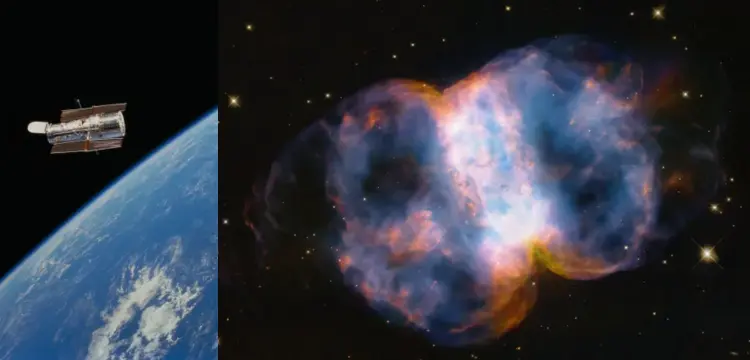The Hubble Space Telescope has captured a stunning new image of the glowing gas ejected from a dying star, which in this case happens to resemble a “cosmic dumbbell.” This portrait may also include evidence that the star gobbled up another star, in a form of stellar cannibalism, before it collapsed.
NASA released the image of the Little Dumbbell Nebula, also known as Messier 76 or M76, to celebrate the 34th anniversary of the April 24, 1990, launch of the space observatory. The nebula, located 3,400 light-years away in the Perseus constellation, is an expanding shell of gases expelled by a dying red giant star. Despite its name, a planetary nebula has nothing to do with planets; the term was coined because such nebulae initially resembled planet-like disks when first observed.
Also Read: Scientists Reveal Astonishing Secrets of Newly Discovered Planet
The Little Dumbbell Nebula has a unique, dumbbell-like shape that has made it a favorite of both professional and amateur astronomers. It includes a ring of gas and dust that appears from our perspective as a central bar connecting two lobes. This ring was likely shaped by a companion star, which the red giant star may have swallowed, leaving behind the ring as forensic evidence of this cosmic act of cannibalism.
The collapsed red giant star has now become an ultra-dense white dwarf star, which is the bright white light at the center of Hubble’s image. This white dwarf has a blazing temperature of 250,000 degrees Fahrenheit (138,871 degrees Celsius), making it one of the hottest known white dwarf stars.
The two lobes seen in the image represent hot gas escaping and being propelled across space at 2 million miles per hour by a stellar wind. This wind collides with cooler, slower-moving gas expelled earlier in the star’s life, causing the gases to glow in different colors representing various elements, such as red for nitrogen and blue for oxygen.
Astronomers estimate that within 15,000 years, the nebula will vanish from the night sky as it continues to expand and grow dimmer. The Little Dumbbell Nebula is just one of 53,000 astronomical objects that Hubble has observed over 34 years, making 1.6 million observations in total. These observations, along with those from the James Webb Space Telescope, help astronomers unravel the mysteries of supernovas, distant galaxies, exoplanets, and other celestial phenomena.











